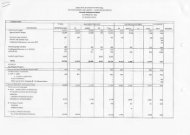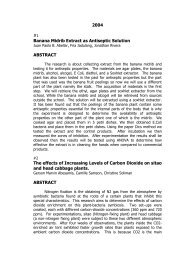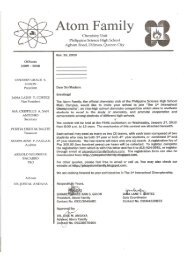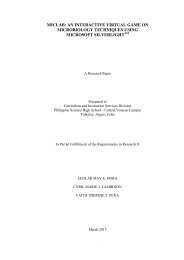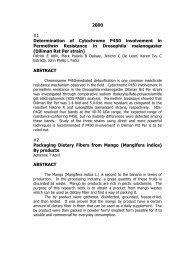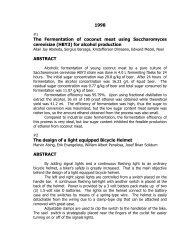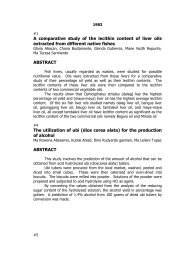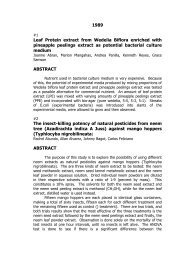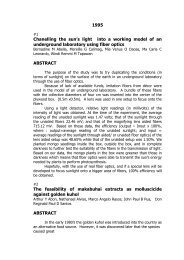2008 Analysis of the Geometry of Drilled Holes in Demolition ...
2008 Analysis of the Geometry of Drilled Holes in Demolition ...
2008 Analysis of the Geometry of Drilled Holes in Demolition ...
You also want an ePaper? Increase the reach of your titles
YUMPU automatically turns print PDFs into web optimized ePapers that Google loves.
#4<br />
Production <strong>of</strong> Cellulose-Chit<strong>in</strong> Films Us<strong>in</strong>g LiCl/DMAc Solvent<br />
System<br />
Maria Kim Feliz N. Abog, Ana Gabriela T. Gatchalian, Maria Sylvia C. Nachura<br />
ABSTRACT<br />
Due to <strong>the</strong> general availability <strong>of</strong> plastics, people assume that it is cheaper<br />
to manufacture more <strong>of</strong> it than to reuse it. Unfortunately, this practice contributes<br />
to <strong>the</strong> buildup <strong>of</strong> non-biodegradable wastes <strong>in</strong> landfills. The solvent system<br />
LiCl/N,N-dimethylacetamide (LiCl/DMAc) has been known to dissolve both chit<strong>in</strong><br />
and cellulose. It has been used <strong>in</strong> <strong>the</strong> formation <strong>of</strong> chit<strong>in</strong> and cellulose films. In<br />
this study, <strong>the</strong> ability <strong>of</strong> LiCl/DMAc solvent system to produce an aggregate film<br />
composed <strong>of</strong> chit<strong>in</strong> and cellulose was determ<strong>in</strong>ed. Chit<strong>in</strong> was first extracted from<br />
squid pen, accord<strong>in</strong>g to <strong>the</strong> methodology <strong>of</strong> Le Gal and Ulber (2005). An amount<br />
<strong>of</strong> 0.12 g <strong>of</strong> extracted chit<strong>in</strong> and 0.12 g <strong>of</strong> commercially available cellulose were<br />
dissolved <strong>in</strong> 5% LiCl/DMAc to test if films can be formed through this method. The<br />
mixture formed a gel-like substance with a def<strong>in</strong>ite shape. The substance was<br />
<strong>the</strong>n flattened out to form <strong>the</strong> film. The biodegradability <strong>of</strong> <strong>the</strong> film was tested<br />
aga<strong>in</strong>st a negative control <strong>of</strong> commercially available plastic wrap us<strong>in</strong>g <strong>the</strong> soil<br />
burial test. The test, conducted at room temperature, us<strong>in</strong>g soil compost <strong>of</strong> with a<br />
pH <strong>of</strong> 7, lasted for two weeks. It showed that barely 10% <strong>of</strong> <strong>the</strong> orig<strong>in</strong>al weight <strong>of</strong><br />
<strong>the</strong> films was left, which means that <strong>the</strong> films produced are <strong>in</strong>deed biodegradable.<br />
The negative control, on <strong>the</strong> o<strong>the</strong>r hand, showed no weight loss at all. It was<br />
concluded that <strong>the</strong> LiCl/DMAc solvent system can produce biodegradable chit<strong>in</strong>cellulose<br />
aggregate films, but <strong>the</strong> flims<strong>in</strong>ess <strong>of</strong> <strong>the</strong> said films made <strong>the</strong>m<br />
unsuitable as a commercial plastic substitute. Fur<strong>the</strong>r process<strong>in</strong>g <strong>of</strong> <strong>the</strong> films to<br />
<strong>in</strong>crease <strong>the</strong>ir tensile strength and additional research on cheaper solvents that<br />
could substitute for more expensive LiCl/DMAc solvent system are recommended.<br />
#5<br />
An All-Organic solution for hydroponics<br />
Anna Lynn C Alcaraz, Trisha Mae S Perez, Aldr<strong>in</strong> Raphael G Mariano<br />
ABSTRACT<br />
An all-organic solution made up <strong>of</strong> coconut water, rice wash (hugas bigas),<br />
extracts from fermented garlic, fish entrails and banana stalks was formulated as<br />
a cheaper and more environment-friendly substitute for syn<strong>the</strong>tic solutions <strong>in</strong><br />
hydroponics.<br />
Garlic was fermented <strong>in</strong> g<strong>in</strong> to extract protective enzymes needed by<br />
plants, while banana stalks and fish entrails were separately fermented <strong>in</strong> brown<br />
sugar. The extracts from banana stalks and fish entrails served as sources <strong>of</strong>



